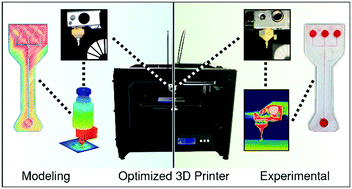Understanding and improving FDM 3D printing to fabricate high-resolution and optically transparent microfluidic devices†
Abstract
The fabrication of microfluidic devices through fused deposition modeling (FDM) 3D printing has faced several challenges, mainly regarding obtaining microchannels with suitable transparency and sizes. Thus, the use of this printing system to fabricate microdevices for analytical and bioanalytical applications is commonly limited when compared to other printing technologies. However, for the first time, this work shows a systematic study to improve the potential of FDM 3D printers for the fabrication of transparent microfluidic devices. Several parameters and printing characteristics were addressed in both theoretical and experimental ways. It was found that the geometry of the printer nozzle plays a significant role in the thermal radiation effect that limits the 3D printing resolution. This drawback was minimized by adapting an airbrush tip (0.2 mm orifice diameter) to a conventional printer nozzle. The influence of the height and width of the extruded layer on the resolution and transparency in 3D-printed microfluidic devices was also addressed. Following the adjustments proposed, microchannels were obtained with an average width of around 70 μm ± 11 μm and approximately 80% visible light transmission (for 640 μm thickness). Therefore, the reproducibility and resolution of FDM 3D printing could be improved, and this achievement can expand the capability of this printing technology for the development of microfluidic devices, particularly for analytical applications.



 Please wait while we load your content...
Please wait while we load your content...